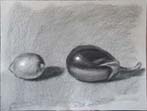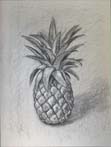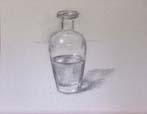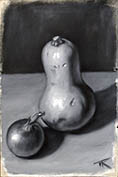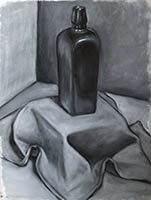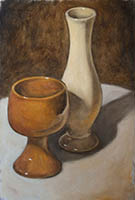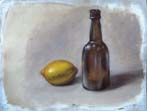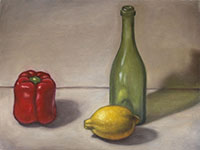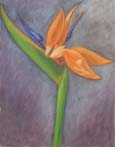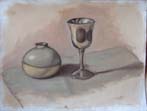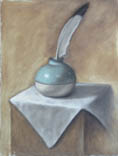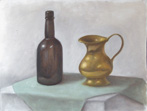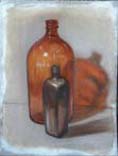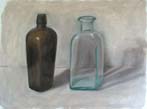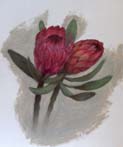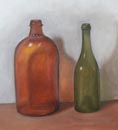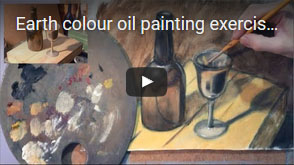Oil Painting Classes
In this class, I teach a traditional style of oil painting, starting with the basics and working up to more advanced techniques. The class is suitable for beginners as well as for more experienced painters who want to learn a different approach to painting.
The emphasis of the class is on realism, which means representing form, tone, and colour in a convincing manner. Realism does not necessarily entail a high level of detail, and in the class, we focus on quick, painterly exercises in order to facilitate learning.
We start by training the eye with still-life drawings in charcoal and chalk. This medium lends itself to a messier, looser way of drawing, with a focus on form and tone rather than detail, and is a good starting point for working with oil paint.
We then approach painting using only black and white paint. This helps students to learn how to handle the paint and brushes without the added complication of colour mixing. This also helps to further train the eye to see tonal values without the distraction of colour.
Next, a few earth colours are added to the palette. A full range of muted colours can be mixed from this palette. Limiting the palette at this stage helps to strengthen the students’ colour mixing abilities, and teaches them about achieving colour harmony. Finally, the stronger primary colours are introduced to extend the range of the palette.
After this, we go on to working on longer projects, working in layers and utilising techniques such as glazing and scumbling.
TIMES AND COST
• The oil painting classes are every second Saturday from 9 am to 12 pm.
Classes are R300 a lesson. This excludes the costs of materials. Colours are slowly introduced during the course, so an initial outlay for a complete set of paints is not necessary.
The classes are held in a friendly and relaxed environment, and we have a break for tea and biscuits halfway through the lesson.
The location depends on the number of students in the class. Small classes are held at my house in Scottsville.
Please contact me for more information or to join the class.
EXAMPLES OF
CLASS EXERCISES
Charcoal Drawings
Painting with Black and White
Adding Earth Colours
Adding Primary Colours
Working in Layers
Video examples of class exercises:
Black and White
Earth Colour
MATERIALS
The list below is a guidline for the structured oil painting classes, and an up-to-date list will be given to students before the classes start.
*The Winsor & Newton paints can mostly be substitued with certain cheaper brands that I have tested. It is not advisable to buy paints for the class without first discussing with me. Colour and quality vary greatly between brands.
Lesson 1 and 2 (Charcoal Drawing)
• A box of charcoal sticks (e.g. Ashrad, medium or assorted sizes)
• White chalk (blackboard chalk is fine)
• Kneadable eraser (an old one is fine if you have)
• Grey card (large sheets, can be cut in four)
Lesson 3 and 4 (Painting in Black and White)
• Winsor & Newton Winton* oil paint (37ml tube):
- Ivory Black
- Titanium White
• Brushes (minimum; two of each is preferred):
- Dynasty / Ashrad Size 6 filbert
- Dynasty / Ashrad Size 4 filbert
• Refined linseed oil (100 ml from art store)
• Artist's white spirit / low odour solvent (100 ml from art store)
• Palette knife
• Something to use as a palette
• Grapeseed oil for cleaning brushes (750 ml from supermarket)
• Grey card
• DALA Canvas Primer
• Paper towels
• One or two jars with lids
Lesson 5 and 6 (Introducing Earth Colours)
• Winsor & Newton Winton* oil paint (37ml tube):
- Yellow Ochre
- Light Red
- Raw Umber
- Burnt Sienna
Lesson 7 (Introducing Primary Colours)
• Winsor & Newton Winton* oil paint (37ml tube):
- Cadmium Yellow Pale Hue
- Cadmium Red Hue
- Cobalt Blue Hue
After this, other colours can be bought when necessary. Some other useful colours are French Ultramarine, Permanent Alizarin Crimson, and Sap Green.
Notes:
Card and primer : The grey card is called "chipboard" in some stores and "thin puzzleboard" in others. The Dala Canvas Primer is a good primer to work on (the "Gesso" is similar but is very absorbant, making it hard to spread the paint around).
Brushes : I put the Dynasty or Ashrad brushes on the list as they are about the best of the cheap brushes. The Dala are similar but their size numbers are different. The Mont Marte ones are also good. Different brands have different sizing systems, so just bear that in mind. You can obviously get better quality if you want, but anything cheaper than the Dynasty tend to fall apart while you are working. You can get more than what's on the list, and different shapes and sizes as well. Filberts and rounds are the most useful.
Palette knife : These are for mixing paint on your palette. Get one with a long, flexible blade.
Palettes : Any smooth, flat surface will do: glass, tiles, old plates. If you buy a new wooden palette rub some linseed oil into it and give it a few days to dry, because they are abdsorbant and suck the oil out of the paint.
Refined linseed oil and solvent : the cheaper art store brands are fine for our purposes, and small bottles will suffice. Try find a low odour turps or white spirit. These are for painting with, not for cleaning brushes. Hardware store oil and turps are not suited for painting.
Cleaning brushes : You can use turps (hardware store) if you prefer but you can also use a vegetable oil, which is a bit more work but healthier for you and for the brushes! If you are cleaning while you are working linseed oil is best because it is what is in the paint. If you are just cleaning at the end of the session something like grapeseed oil is better because it won't gum up the brush over time (it's not a drying oil like linseed oil). It's always better to have more brushes at hand so that you don't need to stop to clean while you are working. Whether you use turps or oil to clean the brushes, you also need to wash them with soap and water at the end of the day. The cheap green bars of Sunlight soap or dishwashing liquidare fine for this.
Paints : I prefer you use Winsor & Newton Winton (student range), because colours vary from brand to brand, especially earth colours, and cheap paints can be difficult to work with. I have tested some cheaper alternatives and will discuss these with the class.
All material copyright © Peter Rippon - All Rights Reserved
